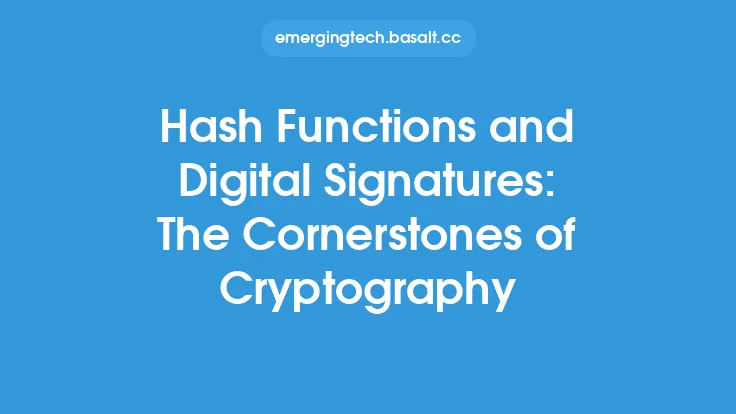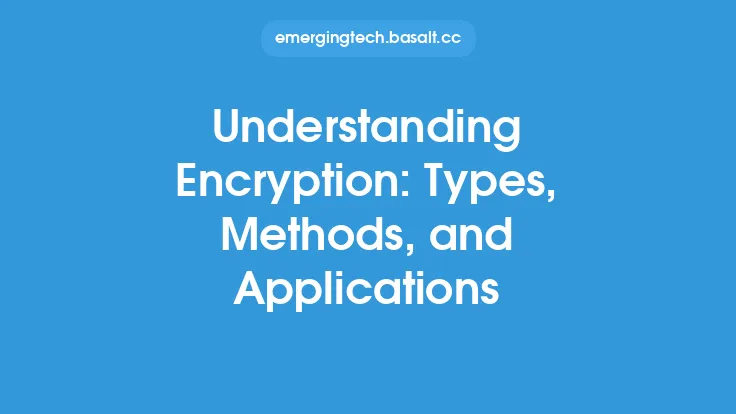Cryptography is a vital component of modern cybersecurity, and various algorithms are used to secure data and communications. Among these, AES, RSA, and Elliptic Curve Cryptography (ECC) are three of the most widely used and respected cryptography algorithms. Each has its strengths and weaknesses, and understanding their differences is crucial for selecting the most suitable algorithm for a particular application.
Introduction to AES
The Advanced Encryption Standard (AES) is a symmetric-key block cipher that is widely used for encrypting data at rest and in transit. Developed by Joan Daemen and Vincent Rijmen, AES was adopted as a standard by the National Institute of Standards and Technology (NIST) in 2001. AES uses a variable block size and key size, with a maximum key size of 256 bits. The algorithm operates on a 4x4 matrix of bytes, using a series of substitution, transposition, and mixing operations to transform the plaintext into ciphertext. AES is known for its high speed, low latency, and resistance to various types of attacks, including brute-force and side-channel attacks.
Introduction to RSA
The Rivest-Shamir-Adleman (RSA) algorithm is an asymmetric-key algorithm that is widely used for secure data transmission and digital signatures. Developed in 1978 by Ron Rivest, Adi Shamir, and Leonard Adleman, RSA is based on the mathematical concept of modular exponentiation. The algorithm uses a pair of keys: a public key for encryption and a private key for decryption. The security of RSA relies on the difficulty of factoring large composite numbers, which makes it computationally infeasible to determine the private key from the public key. RSA is commonly used for secure web browsing, email encryption, and digital signatures.
Introduction to Elliptic Curve Cryptography
Elliptic Curve Cryptography (ECC) is an asymmetric-key algorithm that is based on the mathematical concept of elliptic curves. Developed in the 1980s by Victor Miller and Neal Koblitz, ECC is a more recent addition to the cryptography landscape. ECC uses a smaller key size than RSA to achieve the same level of security, which makes it more efficient and scalable. The algorithm operates on a finite field, using the properties of elliptic curves to create a secure key exchange. ECC is widely used in modern cryptographic protocols, including SSL/TLS, IPsec, and PGP.
Comparison of AES, RSA, and ECC
When comparing AES, RSA, and ECC, several factors come into play, including key size, performance, security, and scalability. AES is generally faster and more efficient than RSA and ECC, making it suitable for high-speed applications such as disk encryption and secure web browsing. RSA, on the other hand, is more commonly used for digital signatures and secure data transmission, where the larger key size provides an additional layer of security. ECC, with its smaller key size and faster performance, is gaining popularity for applications where scalability and efficiency are critical.
Key Size and Security
The key size of a cryptography algorithm is a critical factor in determining its security. A larger key size generally provides better security, but it also increases the computational overhead. AES, for example, uses a variable key size, with a maximum key size of 256 bits. RSA, on the other hand, uses a key size that is typically measured in bits, with a minimum key size of 1024 bits. ECC, with its smaller key size, can achieve the same level of security as RSA with a significantly smaller key size. For example, a 256-bit ECC key is equivalent to a 3072-bit RSA key.
Performance and Scalability
The performance and scalability of a cryptography algorithm are critical factors in determining its suitability for a particular application. AES, with its symmetric-key design, is generally faster and more efficient than RSA and ECC. RSA, on the other hand, is more computationally intensive, which can make it slower and less scalable. ECC, with its smaller key size and faster performance, is gaining popularity for applications where scalability and efficiency are critical.
Side-Channel Attacks and Countermeasures
Side-channel attacks are a type of attack that targets the implementation of a cryptography algorithm, rather than the algorithm itself. These attacks can be used to recover sensitive information, such as the private key, by analyzing the power consumption, timing, or electromagnetic radiation of the device. To counter these attacks, various countermeasures can be implemented, including masking, blinding, and secure coding practices. AES, RSA, and ECC are all vulnerable to side-channel attacks, but ECC is generally more resistant due to its smaller key size and faster performance.
Quantum Computing and Post-Quantum Cryptography
The advent of quantum computing poses a significant threat to modern cryptography algorithms, including AES, RSA, and ECC. Quantum computers can potentially break many of the encryption algorithms currently in use, including RSA and ECC. To address this threat, researchers are exploring new cryptography algorithms that are resistant to quantum attacks, such as lattice-based cryptography and code-based cryptography. AES, with its symmetric-key design, is generally more resistant to quantum attacks than RSA and ECC.
Conclusion
In conclusion, AES, RSA, and ECC are three of the most widely used and respected cryptography algorithms. Each has its strengths and weaknesses, and understanding their differences is crucial for selecting the most suitable algorithm for a particular application. By considering factors such as key size, performance, security, and scalability, developers and organizations can make informed decisions about which algorithm to use. As the cryptography landscape continues to evolve, it is essential to stay informed about the latest developments and advancements in cryptography, including the threat of quantum computing and the emergence of post-quantum cryptography.





